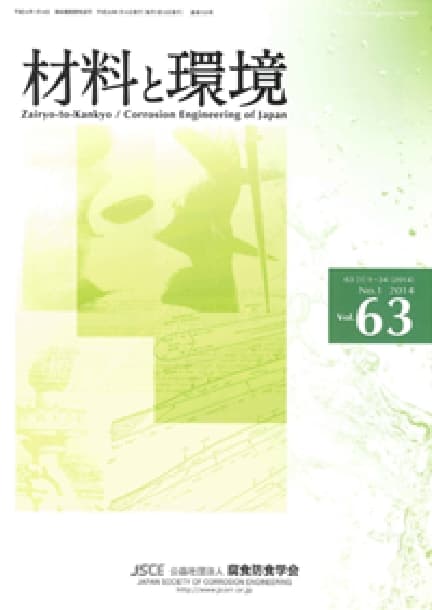- TOP
- Zairyo-to-Kankyo
- Vol. 56 (2007), No. 2
Zairyo-to-Kankyo Vol. 56 (2007), No. 2
Backnumber
-
Vol. 74 (2025)
-
Vol. 73 (2024)
-
Vol. 72 (2023)
-
Vol. 71 (2022)
-
Vol. 70 (2021)
-
Vol. 69 (2020)
-
Vol. 68 (2019)
-
Vol. 67 (2018)
-
Vol. 66 (2017)
-
Vol. 65 (2016)
-
Vol. 64 (2015)
-
Vol. 63 (2014)
-
Vol. 62 (2013)
-
Vol. 61 (2012)
-
Vol. 60 (2011)
-
Vol. 59 (2010)
-
Vol. 58 (2009)
-
Vol. 57 (2008)
-
Vol. 56 (2007)
-
Vol. 55 (2006)
-
Vol. 54 (2005)
-
Vol. 53 (2004)
-
Vol. 52 (2003)
-
Vol. 51 (2002)
-
Vol. 50 (2001)
-
Vol. 49 (2000)
-
Vol. 48 (1999)
-
Vol. 47 (1998)
-
Vol. 46 (1997)
-
Vol. 45 (1996)
-
Vol. 44 (1995)
-
Vol. 43 (1994)
-
Vol. 42 (1993)
-
Vol. 41 (1992)
-
Vol. 40 (1991)
Keyword Ranking
16 Dec. (Last 30 Days)
Zairyo-to-Kankyo Vol. 56 (2007), No. 2
Evaluation of Crevice Corrosion Incubation Time for Stainless Steels Polished Just before Potentiostatic Tests in Chloride Ion Environments
Ryo Matsuhashi, Kenji Katoh, Michiro Kaneko
pp. 56-61
DOI:
10.3323/jcorr.56.56Abstract
Incubation time for crevice corrosion of stainless steels in environments containing chloride ions such as sea water was evaluated by potentiostatic methods. Current density of specimens with and without crevice were measured at a current - time curve just after polish of the sample's surface. And, dependence of QINCU (amount of dissolved metal ions during estimated incubation time) and tINCU ( estimated incubation time for crevice corrosion) on potential were clarified by the experiments above.
The tINCU was decreased with increasing potentials. On the other hand, QINCU was almost independent of potentials. Decrease of tINCU with increasing potentials was due to increase of iINCU with potential. Amount of dissolved metal ions required for occurrence of crevice corrosion and depassivation pH which is fundamental cause for crevice corrosion are found to be almost independent of potential.
Experimental Evaluation of Crevice Corrosion Depth for Stainless Steels in Sea Water Environments
Ryo Matsuhashi, Kazumi Matsuoka, Michiro Kaneko
pp. 62-69
DOI:
10.3323/jcorr.56.62Abstract
Growth rates of crevice corrosion for various stainless steels in sea water environments were evaluated under potentiostatic condition. And perforation time for the stainless steel plate was estimated by time dependence of the maximum crevice corrosion depth.
Crevice corrosion resistance of stainless steels deteriorated with increase of chloride ion concentration. Crevice corrosion initiated and grew for all the stainless steels tested in this study in the solutions with more than 100 ppm chloride ion. Dmax, maximum crevice corrosion depth, was approximated as power low function as Dmax=A·tm. Term A, Dmax at 1 hour, was increased with chloride ion concentration. On the other hand, term m showed from 0.3 to 0.5 independent with chloride concentration. It seems that values of m should be explained by dissolved morphology at corrosion crevice and assuming rate determining step for metal dissolution. For example, perforation time of crevice corrosion for the 1 mm thick SUS 304 stainless steel in 19 ppm chloride ion solution at 50ºC was estimated about 4 years, 21 years for SUS316L stainless steel and 66 years for SUS329J4L stainless steel. And perforation times for SUS304 stainless steel were almost same under potentiostatic condition between 300 mV (vs. SSE) and 440 mV (vs. SSE).
Readers Who Read This Article Also Read
Zairyo-to-Kankyo Vol.55(2006), No.2
Zairyo-to-Kankyo Vol.55(2006), No.4
Zairyo-to-Kankyo Vol.55(2006), No.5
Electrochemical Measurements by the External Pressure Balanced Reference Electrode System and the Evaluation of Thermal Diffusion Potential in High Temperature and High Pressure Aqueous Solutions
Toshiyuki Sunaba, Tetsuo Fujii, Koji Tachibana
pp. 70-75
DOI:
10.3323/jcorr.56.70Abstract
The External Pressure Balanced Reference Electrode (EPBRE) system was applied to the electrochemical measurements in high temperature and high pressure aqueous solutions. Irreversible potentials arisen in the EPBRE system, such as liquid junction potential and thermal junction potentials were studied with comparison to the internal reference electrode system in 0.1 M KCl solutions at high temperatures. It was demonstrated that the potential measured by EPBRE system can be converted to the potentials referenced to standard hydrogen electrode potential at high temperature and also at 25ºC. The contribution of liquid junction potential and thermal diffusion potentials to the measured values was also evaluated in the EPBRE system.
Article Access Ranking
16 Dec. (Last 30 Days)
-
Delayed Fracture Mechanism of 1700 MPa-Class Quenched and Tempered Bolt under Atmospheric Corrosion Environment
Tetsu-to-Hagané Advance Publication
-
Perspectives on the Promising Pathways to Zero Carbon Emissions in the Steel Industry toward 2050
ISIJ International Vol.65(2025), No.2
-
Effect of B on Surface Oxidation Behavior and Phosphatability of Si-Mn-added Cold-Rolled Steel Sheets
ISIJ International Advance Publication
-
Factors Influencing the Bonding Phase Structure of Iron Ore Sinters
ISIJ International Vol.43(2003), No.9
-
Effect of microstructural heterogeneity on fatigue limit of as-quenched low-carbon low-alloy martensitic steel
ISIJ International Advance Publication
-
Prussian blue as a fully reversible hydrogenochromic material for visualizing hydrogen distribution in Fe sheet
ISIJ International Advance Publication
-
Progress of Strip Casting Technology for Steel; Historical Developments
ISIJ International Vol.52(2012), No.12
-
-
Microstructures and Reduction Properties of High CaO Concentration Sintered Ore
ISIJ International Advance Publication
-
Influence of Antimony on the Oxidation Characteristics of 65Mn Steel
ISIJ International Advance Publication
You can use this feature after you logged into the site.
Please click the button below.










